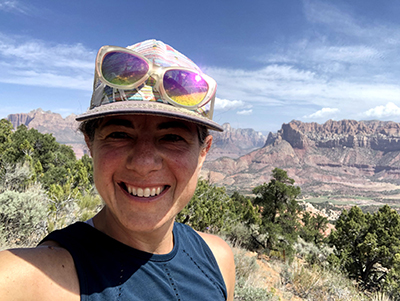HMHI Expert Spotlight: Amanda Bakian, PhD

This month is Autism Awareness Month and we are spotlighting a researcher at the forefront of austism spectrum disorder research in Utah.
Amanda Bakian, PhD, is a Research Associate Professor, environmental epidemiologist, biostatistician, and Director of the Utah Registry of Autism and Developmental Disabilities (URADD). She is also the principal investigator of the Utah Autism and Developmental Disabilities Monitoring project, which aims to estimate the prevalence of autism in Utah and determine how the characteristics of children with autism have changed over time.
"I enjoy working in an academic setting surrounded by colleagues doing fascinating and important clinical, investigative, and academic-related work."
Amanda Bakian, PhD
We asked Dr. Bakian a few questions about her research, her work at HMHI and what she enjoys doing when she is not working!
What is your area/areas of specialty?
My research investigates environmental, familial, geographical, and contextual contributors to the risk of psychiatric conditions such as autism spectrum disorder (ASD) and suicide. I have followed a somewhat non-linear research trajectory to reach my current focus. I was drawn to science, and especially biology and understanding the living world from a young age. Eventually, I became intrigued with how animals respond to the natural environment and specifically the fields of ecology and evolutionary biology. As a doctoral student, I trained as a behavioral ecologist and statistician. Now, I think of myself as a human ecologist who asks questions about how the natural, social and contextual environments impact people's mental health. For example, I am leading an NIH-funded R01 project that examines how mixtures of ambient environmental exposures such as air pollutants and weather factors influence the risk of suicide and how underlying individual-level susceptibilities may interact with these environmental exposures to impact risk.
What do you love most about the work that you do?
I love being self-directed and picking and choosing where to focus my research attention. I enjoy working in an academic setting surrounded by colleagues doing fascinating and important clinical, investigative, and academic-related work. Hence, the work environment is incredibly stimulating and provides opportunities for intellectual and professional development. Finally, due to my training in statistics, I like having a unique and practical skill set that enables me to bridge disciplines and collaborate with diverse research teams.
What is the latest update(s) on your research?
As April is Autism Awareness Month, I'd like to focus on some recent autism-related research. I'm currently directing the Utah Registry of Autism and Developmental Disabilities (URADD), a joint effort between Psychiatry and the Utah Department of Health. URADD is tasked with estimating the prevalence of autism spectrum disorder (ASD) in Utah and describing characteristics and outcomes among individuals with ASD. In collaboration with the Centers for Disease Control and Prevention, URADD recently published updated prevalence estimates for ASD among 4- and 8-year-old children in Utah. We found that the prevalence of ASD has increased significantly among 8-year-old children over the past six years. Interestingly, in contrast to prior years, we found that the prevalence of ASD was highest among 8-year-old children residing in the lowest median household income, which suggests improved access to diagnostic services for children across the socioeconomic status spectrum. This is good news as it is critical for all children with ASD to have access to diagnostic and treatment services irrespective of socioeconomic status.
How does the research you do help patients?
URADD's research on ASD prevalence has been used to develop policy and legislation to support families with children affected by ASD. For example, ASD prevalence estimates from studies conducted in 2010 and 2012 were used to support passage of SB 57, Utah's autism insurance bill, enacted in 2014. Data from URADD has also been used to support legislation providing treatment funding for adults with ASD and funding for training for law enforcement officers on recognizing and interacting with autistic individuals. It is extremely fulfilling to see research that I've been involved with being translated into actual policy that benefits families and our communities!
What research are you hoping to work on next?
Now that I am an associate professor and a mid-career investigator, I am excited about mentoring trainees and junior faculty in their professional and research development. I have been fortunate to benefit from some exceptional mentoring both here at the University of Utah and while a graduate student. I would like to pass along guidance and experience to the next generation of researchers. In addition, down the road, I would like to leverage some of my research findings in autism and suicide to support mechanistic-based, prospective studies. While this is a new area for me, I have started to collect some pilot data to develop these ideas. For example, I recently acquired pilot funding from the NIH's Human Health Exposure Analysis Resource to measure analytes of environmental exposure in hair samples from suicide decedents. I am hoping that this pilot data will support a larger project investigating exposure signatures in the months prior to death among suicide decedents to better understand proximal exposure risks prior to death.

What are you passionate about outside of work?
I knew pretty immediately that I was a “desert rat” during my first visit to southern Utah 24 years ago while backpacking through Escalante National Monument. This, coupled with being an avid skier, made moving to Utah an easy decision. I've been living here for the last 23 years and love the quality of life and easy access to the incredible landscapes that Utah provides. Outside of work, I enjoy spending time with my family and friends exploring Utah's natural environments. I love to backcountry ski, trail run, hike, rock climb, mountain bike, travel, and camp. In addition, my creative outlet is cooking and entertaining, and my husband and I love to attend live music.